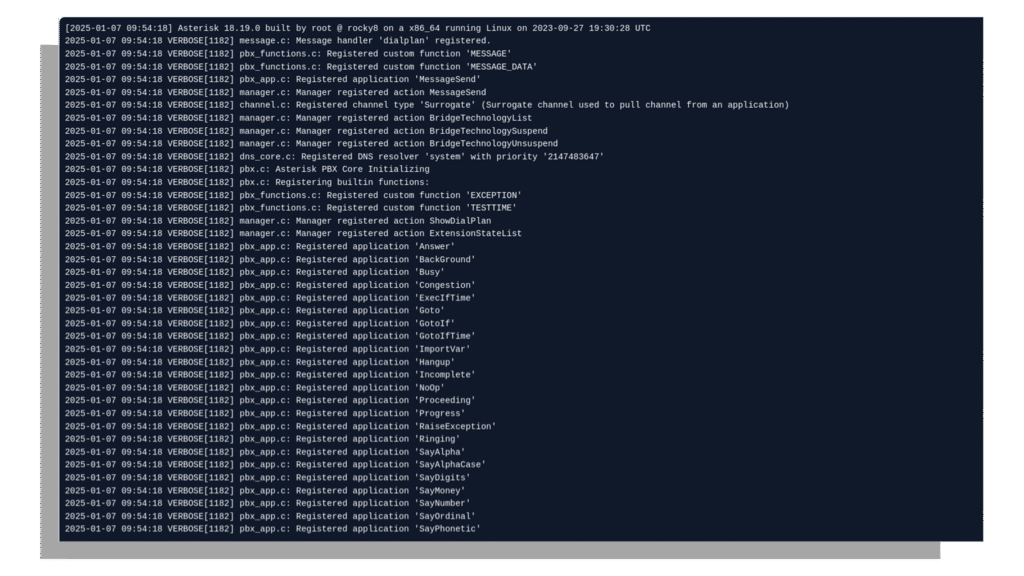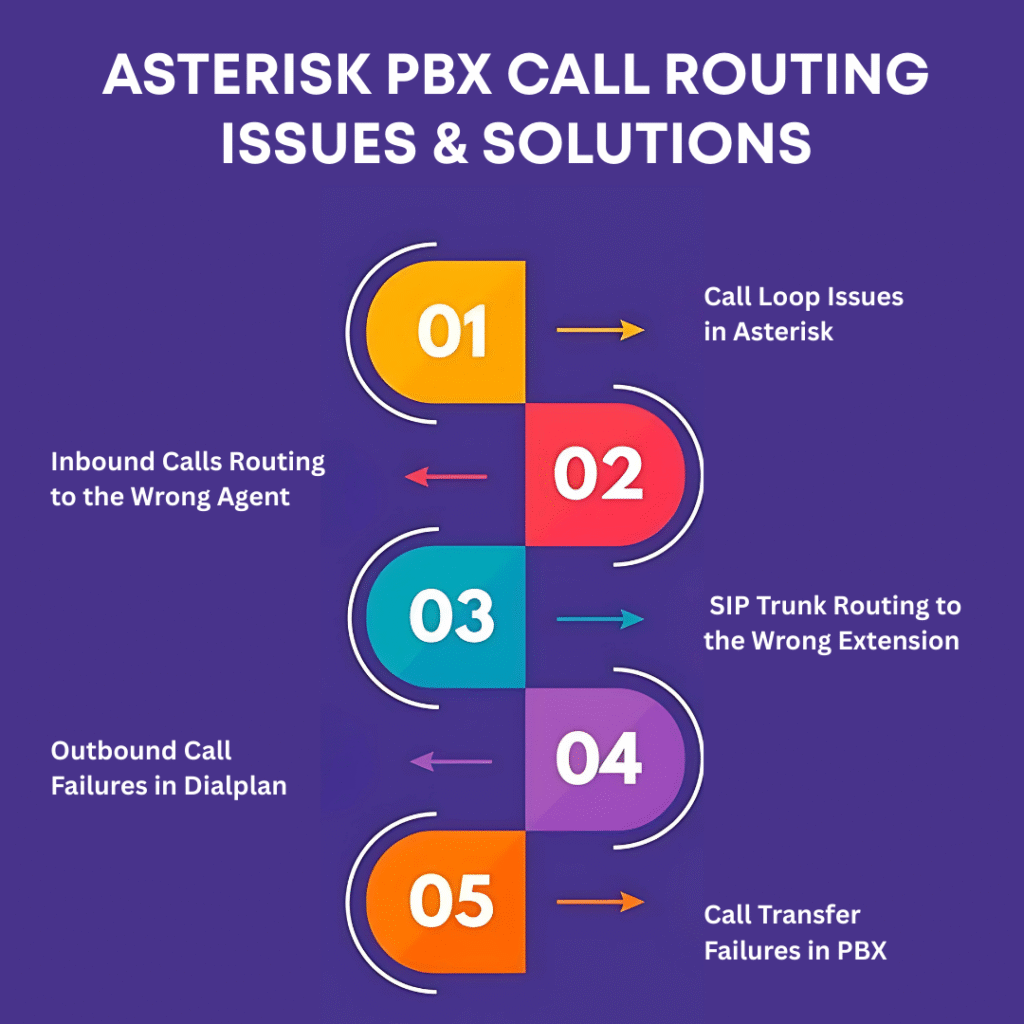
When I first got into setting up call routing with Asterisk, I figured it would be a piece of cake. I just needed to create a dialplan and link up a SIP trunk, and I assumed the calls would just work. But reality hit me hard. Suddenly, inbound calls were landing in the wrong extensions, outbound calls were failing, and clients were screaming about call drops. If you’ve ever faced Asterisk Call Routing Problems and Asterisk troubleshooting nightmares, trust me—you’re not alone.
In this guide, I’ll walk you through how I’ve fixed wrong call routing in Asterisk over the years. You’ll see the most common mistakes, step-by-step fixes, advanced debugging tricks, and even a glimpse of how AI is shaping the future of VoIP troubleshooting.
Why Asterisk Call Routing Problems Happen
If you’ve spent hours staring at your extensions.conf file, you already know the pain. Routing issues don’t appear out of nowhere. They usually come from:
- SIP trunk misconfiguration
- Asterisk dialplan errors (extensions.conf mistakes)
- PBX issues like wrong inbound/outbound rules
- SIP registration failed errors
- Call flow misconfiguration causing call loops
Wrong call routing in Asterisk usually happens due to dialplan errors, SIP trunk misconfiguration, or PBX call flow mistakes. To fix it, debug logs with Asterisk CLI (sip set debug on, core set verbose 10), check inbound/outbound rules, and correct extensions.conf entries.
Step-by-Step Guide to Troubleshoot Asterisk Call Routing
I’ve learned this process the hard way. So here’s the step-by-step Asterisk CLI troubleshooting guide I follow every time:

1. Start with the Logs
Open the Asterisk CLI and run:
- asterisk -rvvv
- sip set debug on
- core set verbose 10
Watch the flow of SIP packets and call attempts. You’ll catch most VoIP call routing errors right here.
2. Check extensions.conf for Mistakes
Common Asterisk dialplan mistakes:
- Typos in extensions
- Missing priorities (n, 1, 2)
- Loops causing endless ringing
I once saw a case where inbound calls kept looping back to the IVR because someone forgot to break the Goto chain.
3. Inspect SIP Trunk Configurations
Wrong IP, username mismatch, or codec issues often cause inbound and outbound call issues. Look for:
- Auth username vs. SIP peer mismatch
- NAT settings
- Missing RTP/codec lines
4. Test Inbound Call Flow
Incoming calls on the Asterisk system aren’t reaching the right destination. Often because DID mapping is wrong in extensions.conf. Double-check DID routes.
5. Test Outbound Dialplan
When outbound calls fail, check carrier permissions and see if dial patterns (_X. rules) match correctly.
Common Asterisk PBX Call Routing Problems and Fixes

1. Inbound Calls Routing to the Wrong Agent
Fixing it is simple: double-check your inbound DID rules and ensure they match the carrier configuration.
2. SIP Trunk Routing to the Wrong Extension
Debugging SIP headers and adjusting the context rules usually resolves the issue.
3. Call Loop Issues in Asterisk
A call loop happens when calls bounce back and forth in the dialplan without reaching a termination point. This typically occurs when circular Goto references are present. The fix is to add proper termination logic and break the loop by refining your dialplan.
4. Call Transfer Failures in PBX
Many admins struggle with call transfer issues in Asterisk-based PBX systems. Problems occur when transfer rules are not properly defined in features.conf or when handovers aren’t tested in real scenarios. Updating the transfer rules and testing internal/external transfers ensures smooth call handling.
5. Outbound Call Failures in Dialplan
Outbound failures usually happen when carrier prefixes, dial patterns, or codec settings don’t match provider requirements. The result is failed calls or one-way audio. To fix this, validate carrier prefixes, adjust dial patterns in the dialplan, and confirm that both ends agree on codecs.
Advanced Debugging Tricks for Asterisk Call Routing
Here are tricks I personally use:
- Real-time call monitoring in Asterisk CLI
- Use SIP trace tools like sngrep for live call flow visualization
- Enable failover routing so one trunk failing doesn’t kill your PBX
- Debugging SIP trunk routing issues in Asterisk with pjsip set logger on
Pro Tip: If you use FreePBX, wrong routing often comes from Asterisk freePBX routing issues with inbound routes. Always check GUI configs along with raw files.
AI-Powered VoIP Troubleshooting
Now here’s where things get exciting. In 2025, AI in call routing isn’t just hype. Real-time AI-powered IVR systems can self-correct call flows. Predictive routing tools use sentiment analysis and historical data to connect callers to the right agent.
Recent Stat: According to Metrigy’s 2024 report, 39% of enterprises already use AI in VoIP call routing to reduce call drops and misrouting.
With tools like AI co-pilot for agents, speech analytics, and real-time VoIP analytics, call centers can predict and fix issues before customers even complain.
Future of Asterisk in Cloud Telephony
I get asked often: “Is Asterisk still relevant in the age of AI and CCaaS?” Absolutely. In fact, with cloud PBX solutions 2025, Asterisk is becoming more powerful. Integrations now include:
- WebRTC browser calling
- CRM integration for smarter routing
- Twilio SIP trunking support
- Home Assistant automation via dialplan
- ConfBridge for HD conference bridging
- Voice biometrics and speech emotion recognition
Asterisk is evolving into a full cloud-based contact center (CCaaS) platform when combined with AI-driven tools.
Best Practices for Managing Asterisk Call Routing
Here’s my personal checklist:
- Always validate extensions.conf after edits
- Use encryption methods for safe VoIP routing
- Set up intrusion detection systems for SIP attacks
- Enable failover routing to backup trunks
- Run real-time analytics to catch misroutes early
FAQs
Q1: How do I debug wrong call routing in Asterisk PBX?
Run sip set debug on and core set verbose 10 in CLI, then follow the call flow. Check for DID mapping errors, SIP trunk mismatches, and dialplan loops.
Q2: Why are inbound calls going to the wrong extension?
This usually happens when DID routes in extensions.conf don’t match carrier mappings. Double-check inbound context rules.
Q3: Can AI fix Asterisk call routing problems?
Yes. Modern AI-powered VoIP troubleshooting tools can detect misroutes, analyze sentiment, and suggest real-time dialplan corrections.
Final Thoughts: Fixing Asterisk Call Routing is Easier Than You Think
When I first faced Asterisk call routing problems, it felt overwhelming. But once I learned to rely on step-by-step CLI debugging, keep my dialplan clean, and embrace AI-powered troubleshooting, everything changed.
My advice? Don’t fear the logs. They’re your best friend. And start exploring new AI-driven solutions—they’ll save you hours of manual debugging.
Want to go deeper? Check out our guides on Predictive Dialers and Advanced Call Center Software Solutions.
Because at the end of the day, smooth call routing isn’t just about fixing problems—it’s about creating the kind of customer experience that keeps people coming back.






